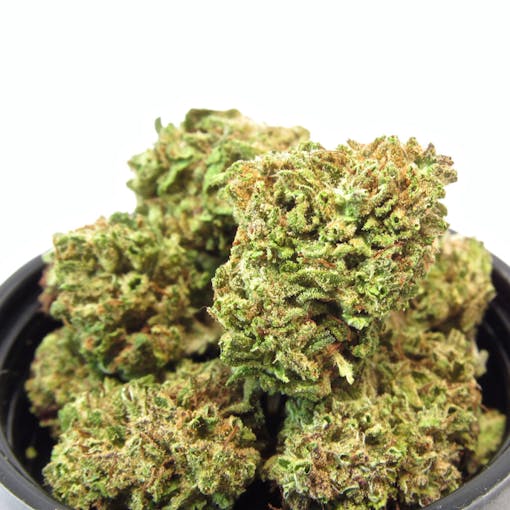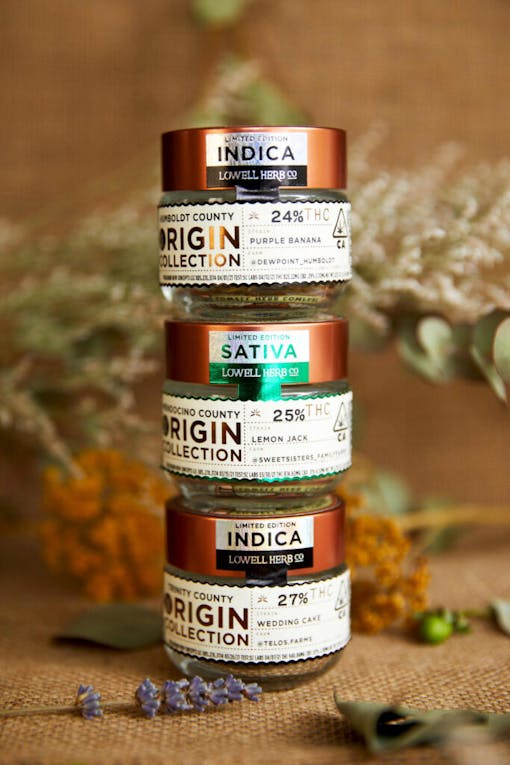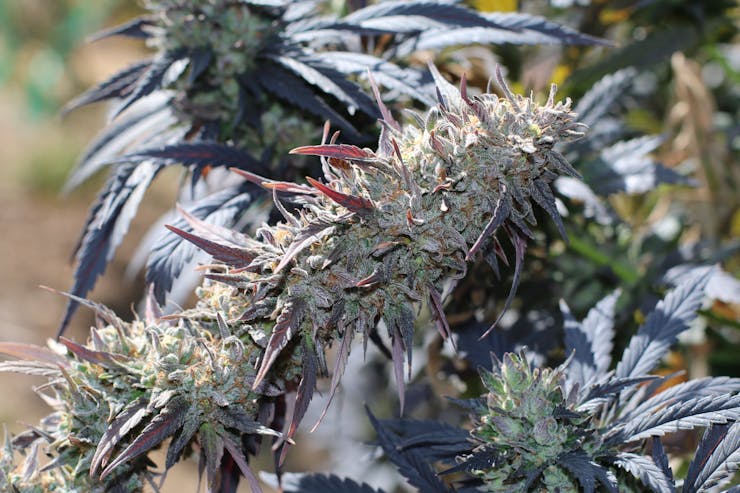Think about the best weed you ever bought from the local dispo. What did it look like? Did it have trichomes that stuck to your fingers? Did it emit an odor so loud you had to double bag it? It definitely left you on your ass.
Now think about how it was grown.
Did it grow in soil under the sun or a temp-controlled warehouse? Is it sitting in a mylar bag or a glass jar on your nightstand?
Maybe you’re thinking, ‘who cares? It passed testing and I’m buying it from a licensed distributor; it must be good.’ But the buck doesn’t stop there.
For many Californians, years of worsening fire seasons and drought make climate anxiety very real, without clear-cut answers or cure-alls. But cannabis has been our societal solution to anxiety for thousands of years, so why not a climate solution, too?
How?
For starters:
- Regenerative and holistic farming practices that abhor pesticides;
- partnerships and certifications that commit brands to shrinking their carbon footprint;
- something as simple as not using plastic packaging.
Cannabis has barely begun to impact the agricultural landscape, and it’s not too late to steer this big rock in the sky towards a greener path, without compromising our greens in the process.
Carlos Perea, CEO, and co-founder of agricultural tech company Terra Vera, sees the drive for sustainably-grown cannabis not unlike the boom in hybrid and electric vehicles. “The reason we see change in these industries is because consumers demand it. Cannabis is the same; everyone has to follow or get left behind.” We rounded up the greenest green California (and some others) have to offer, and spoke to the stewards doing their part to make everything feel less futile and taste more terpy.
Sustainable cannabis cultivation
Flow Kana

The exploding legal cannabis market operates under regulations that protect them from law enforcement, but also complicate farmers’ traditional methods of doing things: more waste is produced in complying with seed-to-sale tracking, which includes tagging every single plant with a plastic card detailing its crop and batch information.
Shop highly rated dispensaries near you
Showing you dispensaries nearIn order to scale up, farmers may opt to use pesticides or convert to indoor growing, where plants can flower multiple times a year due to artificial lights, which canproduce up to 100x the carbon than that produced by outdoor growing.
There is no way to write a cannabis sustainability article without mentioning Flow Kana. I like to think of them as a looming, cannabis umbrella, bringing the harvests of sungrown farmers unable to afford the dues of running their own permitted business to consumers all over California. Two independent farms they have partnered with in the past, Emerald Spirit Botanicals and Canna Country Farms, won first and second place for sungrown flower at the 2021 Emerald Cup Awards for their Pink Boost Goddess and Canna Country #26, respectively. (Emerald Spirit is now with the brand “Farm Cut.”) Last month Flow Kana also launched their Farmer’s Reserve line, a limited release of sungrown, high-THC craft cannabis grown by Woodman Peak and Livicated Farm to further drive the point home: sungrown is where it’s at.
Where to get them:
- Airfield Supply Co in San Jose
- Mountain Remedy Oakland
- The Healing Center San Diego
Aster Farms

There’s a lot to be learned from over 50 years of experience. Aster Farms Co-Founder and President Sam Campodonico-Ludwig was destined to work in cannabis; his family had been growing it in Mendocino for three generations. And in that time, they picked up on a few things: living soil was better than pour-in nutrients, and natural sun would always trump artificial lights. Ludwig’s wife and Aster Farms CEO Julia Jacobson says sustainable practices are crucial to a plant’s viability, but also the depth and potency of the imparted high.
“We believe cannabis is in a very unique position to preach sustainability, in terms of people as well as environmental impact. We grow in the ground, in living soil.” The combination of sunlight and dynamic soil minus fertilizers and spray-on chemicals, she says, “creates a much more complex, deeper high,” even if the THC isn’t clocking 30%.
To make these dank terps easier to try, Jacobson recommends the company’s Day to Night variety pack of pre-rolls with five different terpene profiles for medication in every situation. To keep themselves accountable, they launched the first Sustainability Report on Earth Day to audit their carbon footprint for 2020, detailing their water use, waste output and carbon emissions as well as commitments to improving these figures.
Where to get them:
- Harborside Oakland
- Sweet Flower in Los Angeles
Glass House

The second biggest flower brand in the state is also one that harnesses sunlight and sustainable practices, go figure! Glass House Group President Graham Farrar would also like to remind you that Earth Day was started in Santa Barbara, where the brand grows a spectrum of cultivars in greenhouses, where they get the benefits of indoor without the cost and benefits of outdoor without the crop’s vulnerability. Their eighths and pre-rolls move fast, in a mix of genetics that includes classics like Super Silver Haze (love her) to a more stony and sweet Sugar Tarts. To highlight the work of their cultivators, Glass House released a new craft line of flower called Grower’s Choice, that features what the growers themselves would smoke at home, with industry favorites like Runtz and MAC-1.
“We need to make sure we’re being good ancestors,” says Farrar. Cannabis as an industry comes from compassion. This all starts with the plant, and the plant comes from the planet. It falls on us; we are the generation that needs to make this change.”
Where to get them:
- BASA Collective in San Francisco
- KindPeoples in Santa Cruz
- Farmacy in Berkeley, and Eaze
Stone Road

If the yellow brick road gets you to Oz, the Stone Road must be a trip. This family-run farm in Nevada City, CA is on an unruly plot of land, with a sparse greenhouse layout on nearly 60 acres that allows the feral ecosystem to thrive. They source all their water from a local well and prefer ladybugs over herbicides in their living soil beds to sustain those mini biomes that result in the loudest smoke. They currently produce flower eighths and quarters, pre-rolls with and without hash, pre-ground bulk, and sauce concentrates, all available in either entirely or 99% plastic-free packaging. I must add that I love the pastel color schemes. And since it’s Pride month, shout out to their queer founder Lex Corwin!
Where to get them:
- High Times Delivery SoCal and NorCal and Eaze.
Lowell Farms

Lowell’s packs of joints in paper boxes are omnipresent among California smokers, complete with a small supply of compostable matches. Their sungrown flower is pesticide-free and packaged by the eighth in glass jars, and their live rosin-based vaporizers utilize wood for the tips and bodies of the pen, minimizing plastic use.
Their latest venture is the Origin collection, a curation of flowers cultivated in Mendocino, Trinity, and Humboldt counties that exemplify each of the microclimate’s unique terroirs, the equivalent of the wine appellation system, but for cannabis. Each jar offers genetic and terpene profiles, with an initial lineup of Lemon Jack, Wedding Cake, and Purple Banana.
Where to get them:
- Budz Deli in Los Angeles
- Harborside San Leandro
- Doobie Nights in Santa Rosa
More conscientious indoor
Source Cannabis

Despite the research’s grim prospects, indoor cultivation isn’t a lost cause. The rise of indoor flower, despite its cultish reverence by millennial stoners today, was not necessarily due to superior quality, but self-preservation against incarceration as cannabis became more and more heavily criminalized in the 20th century. If done right, the nugs will take on a celestial quality, as did the White Fire I smoked recently: shimmering with trichomes and cured to perfection. Source Cannabis, an indoor-grown flower based in Los Angeles, toe the sustainability line while cultivating under lights in part due to their Clean Green certification, a program started in 2004 by attorney Chris Van Hook to help cannabis operators achieve standards that follow the USDA National Organic program. The program also commits brands like Source to improving their sustainability metrics over time.
Where to get them:
- Green Gold Delivery in Oakland
- Velvet Cannabis in Martinez
- Evolv Cannabis in Harbor City
Pure Beauty
Water is a huge issue amongst cannabis operators, especially as California enters another drought. So fun! Per the Cannabis H2O: Water Use & Sustainability report co-authored by the
Resource Innovation Institute (RII) and the Berkeley Cannabis Research Center, indoor cultivation use twice as much water as sungrown or greenhouse operators.
Companies like Pure Beauty have been operating with this knowledge in mind for years. The indoor flower company uses no tap or groundwater, instead pulling moisture from the air to feed plants, which also means no runoff full of fertilizers or compounds that disrupt local ecology. They put roly-polys in their soil beds, and have developed a plant-based plastic to complement their paper and glass packaging. Their flower consistently tests high in THC, but it’s the high terpene content and smooth smoke that make breaking down a dank nug or passing around some of their baby pre-rolls that sets them apart. They’re also invested in an equitable, diverse industry not only for the planet but the people acting as its stewards.
Where to get them:
- Liberty Cannabisin San Francisco
- Lytt in Pacifica
- Farmacy in Santa Barbara
Sustainable cannabis packaging
Nasha
Hash is the oldest form of cannabis concentrate, dating back to the days ofA Thousand and One Nights. Compared to the heavy machinery and throttle of energy needed to run a closed-loop extraction system to make cartridges and live resin dabs, hash’s footprint looks like a baby’s. Nasha has been making traditional “temple ball” and the more contemporary sand-like hashish since before Prop 64 and has more recently also begun producing hash-infused pre-rolls. Each pre-roll pairs hash and flower for either an “Altitude” or “Submerge” high that burns nice and slow, and always leaves me slumped. To get the kind of terpene expression present in their temple balls, they partner with small farms that grow outdoor flower and follow regenerative practices to maintain a dynamic biome, including Sunboldt Grown and Alpenglow Farms. As of 2021 they also now package their pre-rolls in recyclable hemp plastic tubes.
Where to get them:
- Abatin Wellness Center in Sacramento
- The Pottery in Los Angeles
- Patient’s Care Collective in Berkeley
Papa & Barkley
Two things connote a Papa & Barkley product: the eponymous man and dog duo on the packaging, and the bamboo accents on topical and tincture lids. The brand has grown from a medicinal-focused brand led by their whole-plant lipid infusion tinctures and pain-zapping topicals to a thriving company for any kind of consumer (minus a smoker purist) with the addition of award-winning ice water hash, rosin-based edibles, and skincare. Chief Product Officer and founder Guy Rocourt is adamant about product purity; there’s nothing artificial, diluting, or unnecessary in his formulas, and he makes sure to reduce environmental impacts wherever possible. The bamboo and glass vessels for their THC:CBD balms and MCT-based sublinguals are completely recyclable, and made with cannabis material sourced directly from small farmers. Having been in the cannabis game for over 20 years, Rocourt is hopeful about the future, provided the adages of the legacy market, like holistic, regenerative practices, are protected.”
“I’m trying to be the change want to see. Cannabis is part of a larger green movement, and when it comes to things like quality, you have to educate them on that. It’s staggering how little people know.”
Where to get them:
- HAVEN in Long Beach
- Farmhouse Artisan Market in Petaluma
- Bloom Room in San Francisco
More sustainable cannabis companies around the US
California, while the biggest state for recreational cannabis, can’t carry the torch alone. Operators across legal states have to contend with their own ecological dilemmas, but their solutions are, unsurprisingly, in line with what’s happening in the Golden State.
Chalice Farms, OR

Oregon’s Chalice Farms is moving over to 100% ocean recycled plastic packaging to start taking trash out of the ocean, as opposed to dumping more in. Their chief Cultivation + Cannabis Community Officer Meghan Miller calls this effort “a really big deal. When you take cannabis out of what we do, we’re agriculture, and agriculture has an impact on the environment.
Lost Coast, CO
Colorado pioneered the recreational market, but Lost Coast Co-founder William Brinkerhoff can admit that they have some work to do when it comes to industry sustainability. His company, which launched during the pandemic, believe that regenerative practices are not only what the planet needs, but what the plant itself needs; the result is a flower that imparts, whether for medicinal or recreational purposes, a high that is more nuanced, long-lasting, and bursting with flavor.
“I’ve grown them side by side, one with synthetics and one with living soil,” he says. “The juice is worth the squeeze.”
Cannasol Farms, WA
Up in Washington state, Jeremy Moberg is fighting the sustainability fight with the Washington Sun Growers Association and his brand, Cannasol Farms. As someone with a background in biology, and whose land was burned significantly by fires in 2015, the connection between climate change and sustainability is evident, but not everyone is willing to have those conversations. He believes that consumer demand drives industry and legislative changes, but lack of education in dispensaries often feeds into the superiority myth of indoor over sungrown.
“It’s infuriating. It’s driven by retailers and low quality outdoor,” he says. “So many people believe the quality of indoor comes from the light source, but it doesn’t.”





